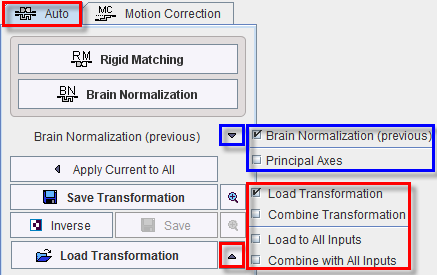In order to use the automatic matching methods, the Auto tab must be brought to the foreground after loading the images. The following interface appears

which contains a series of user interface elements:
Rigid Matching |
Allows accessing different types of rigid matching methods. |
Brain Normalization |
Allows performing procedures for transforming individual brain images into a standard anatomical coordinate space. They require a suitable template image which is already in the standard space, and an elastic matching procedure for warping the images appropriately. (Formerly called Brain Normalization II) |
Option Button 1 |
Contains the historic Brain Normalization (previous) and Principal Axes. Activating either of these buttons pops up a corresponding dialog window as described below for the different methods. |
Apply Current to All |
Copies the transform of the current Input series to all, overwriting the prior transforms. |
|
Shows the parameters of the current transform (as a result of transformation loading, automatic matching or calculation of the inverse). Only the affine component is shown, not the elastic part of the normalizations. |
Save Transformation |
Allows saving the final transformation obtained from initialization, automatic matching, manual adjustments as well as the result of a transformation combination. |
Inverse |
Allows calculating the inverse of the current transformation. Note that this applies also if the current transformation has been calculated by the combination of multiple transformation. |
Save |
Allows saving the inverse transformation. |
Option Button 2 |
Allows loading a transformation which has been saved to disk after a manual or automatic matching process. The following is done with the loaded transformation:
Each time after loading or combining transformations the images are resliced automatically. See the comment above regarding the effect and the allowed combination of transforms. |
The matching methods are described in the following sections.
Note: The performance of the automatic registration methods is highly dependent on the actual images to match!